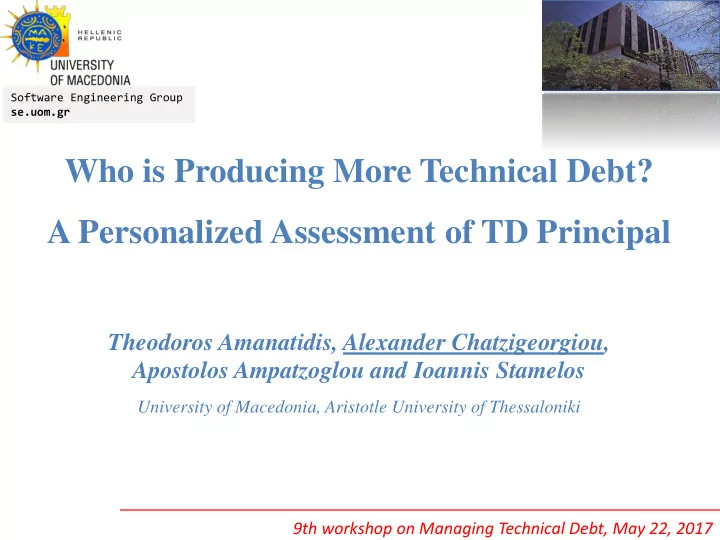

Software Engineering Group se.uom.gr Who is Producing More Technical Debt? A Personalized Assessment of TD Principal Theodoros Amanatidis, Alexander Chatzigeorgiou, Apostolos Ampatzoglou and Ioannis Stamelos University of Macedonia, Aristotle University of Thessaloniki 9th workshop on Managing Technical Debt, May 22, 2017
Context & Goal • TD reduces the velocity during evolution • TD can be assessed on artifacts • However, it’s people that do projects ..and it’s people that introduce TD
Context & Goal Case Study distribution of TD Violation types Relation between among developers per developer TD and maturity RQ1 RQ2 RQ3 • Managers can steer the allocation of tasks • Developers get input for self-improvement
A note on Ethics Processing information at the level of individual developers should be performed with care. In this study gathered personal data has been de-identified. Assessing the contribution of developers to the system’s TD should not share any kind of personal data with third parties. Any type of performance analysis should respect ethics, ensuring for example that: developers are aware of the relevant process any feedback will be accessible by the employees and will remain confidential .
Case Study Design - Projects Size of last year of #Developers Project #Commits version 1st (considered) (LOC) release Laravel (core) 1136 11 149K 2013 Composer 807 7 8K 2012 Yii2 2097 19 406K 2013 Cakephp 1677 23 297K 2008
Case Study Design - Variables [V1] DevID [V2] Total TD [V3] Number of modified lines [V4] Normalized TD
Case Study Design - Variables [V5] Types of TD violations [V6] Developer Maturity
Case Study Design – Data Analysis RQ1 Distribution of TD among developers • Bar charts • Gini Coefficient • Anderson Darling test
Case Study Design – Data Analysis RQ2: Which TD violations are introduced by the developers of a software project? • HeatMap RQ3: relation between TD and maturity Combined Dataset for all projects To avoid bias variables are expressed as % : maturity of each developer divided with the maturity of the most experienced one normalized TD for each developer divided by the maximum normalized TD • ScatterPlot • Correlation Analysis • Independent sample t-test
Distribution of TD among Developers Gini index = 0.66 Gini index = 0.66 Gini index = 0.65 Gini index = 0.61
TD violations per Developer unused code pitfall misra err. handl. design clumsy bug brain- overload
the manager’s perspective unused code pitfall misra err. handl. design convention clumsy cert bug brain- overload
the developer’s perspective unused code pitfall misra err. handl. design cwe convention clumsy cert bug brain- overload
TD vs. Developer Maturity 1 0.8 TD/LOC (normalized) 0.6 0.4 0.2 0 0 0.2 0.4 0.6 0.8 1 -0.2 -0.4 developer maturity (normalized)
to conclude • developers’ competencies vary, since the distribution of TD is highly imbalanced • different developers introduce different TD violations • some recurring violations can be identified across developers and projects • there is no statistically significant evidence that more experienced developers introduce less TD
Software Engineering Group se.uom.gr Thank you for your attention! 9th workshop on Managing Technical Debt, May 22, 2017
Recommend
More recommend